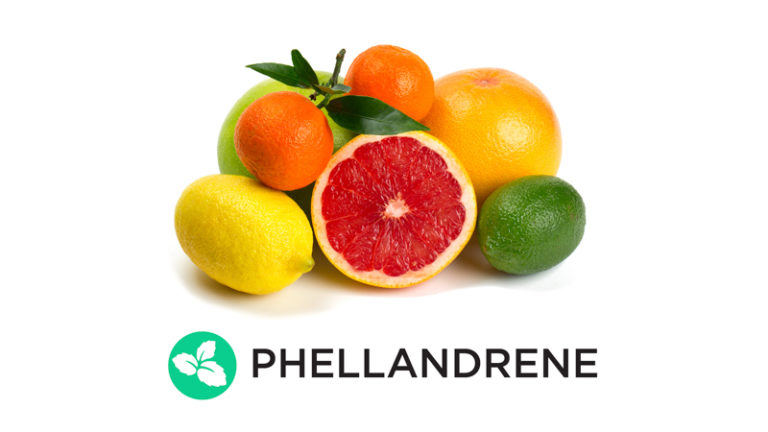 Photo by: Gina Coleman/Weedmaps
Photo by: Gina Coleman/WeedmapsImage lightbox

Phellandrene is a pair of organic compounds, identified as alpha-phellandrene and beta-phellandrene, which share similar molecular structure and chemical properties. Both are classified as monoterpenes and are double-bond isomers. Alpha-phellandrene is a constituent of eucalyptus essential oil, while beta-phellandrene has been isolated from the oils of water fennel and Canadian balsam. Minty and citrus profiles make the phellandrenes popular components in commercial fragrances.
What is phellandrene?
Both alpha-phellandrene and beta-phellandrene are insoluble in water but miscible, or able to be mixed, in ether. Mixing the phellandrenes with ether is what makes it possible to create perfumes and colognes from their essences. The alpha-phellandrene isomer is notable for its potential to form an explosive peroxide on contact with high air temperatures. In cannabis, phellandrene is considered a secondary terpene, meaning that it is not as common as primary terpenes such as myrcene. Chinese medicine has employed phellandrene for centuries through turmeric leaf oil to treat various fungal and bacterial infections. Eastern health practitioners have also developed herbs with this terpene to reduce phlegm and boost energy.
Phellandrene in everyday life
In addition to its presence in certain varieties of cannabis, phellandrene is found in ginger grass, cinnamon, angelica, lavender, mint, dill, parsley, and pine. If you enjoy wearing fresh, forest-inspired fragrances, then you may have experienced phellandrene. As a terpene with culinary usages, phellandrene could be present in dishes as diverse as cinnamon French toast and dill potato salad. Even a scoop of mint chocolate chip ice cream, if made from genuine mint leaves, could offer a glimpse into the aroma and flavor properties of phellandrene. Finally, you may have encountered phellandrene during an aromatherapy massage with the common healing oils of lavender or eucalyptus.
Therapeutic properties of phellandrene
Phellandrene has a long history in Eastern medicine and a developing one in Western medicine. Emerging research has explored the possible effects of alpha-phellandrene and/or beta-phellandrene on cancerous cells, fungi and inflammation.
Anticancer
A study published in 2014 in the journal Nutrition and Cancer found that alpha-phellandrene significantly decreased the viability of human liver tumor cells. More recent studies showed similar results in models of leukemia. Because these were performed on cancerous cells, additional research is needed to determine how alpha-phellandrene could affect clinical cases of cancer.
Fungicide
A 2017 study published in the journal Botanical Studies also demonstrates alpha-phellandrene's potential antifungal benefits. The study measured the ability of alpha-phellandrene to prevent or inhibit the growth of fungus on plants, notably post-harvest tomatoes. Researchers concluded that alpha-phellandrene showed fungicidal activity that could control the Pennicilium cyclopium fungus in tomatoes. The study did not examine alpha-phellandrene's possible effects on fungal infections in humans or animals.
Anti-Inflammation
Many terpenes found in nature have anti-inflammatory properties, and phellandrene is no exception. Interestingly, the mechanisms by which phellandrene reduces inflammation are different than most other terpenes, although these effects still need to be confirmed in human studies.
Analgesic
Several animal studies have demonstrated phellandrene's ability to relieve pain. Either alone or as a major constituent of a plant essential oils, phellandrene appears to have promising effects on several types of pain, including neuropathy (nerve pain).
Role of phellandrene in cannabis
Phellandrene is present in certain types of cannabis but is not nearly as common as primary terpenes like camphene and carene. Like all terpenes, phellandrene may enhance the sensory experience of cannabis through pleasing aromas and flavors. In particular, a peppery or spicy aroma may be experienced when inhaling cannabis that contains phellandrene due to the terpene's pungent and prominent scent-enriching presence. Many patients using cannabis to manage pain and fight cancer may receive subtle benefit from phellandrene's anti-tumor and analgesic effects.
Bottom line
Well-established as a pleasant addition to perfumes and a component of Eastern therapies, alpha and beta-phellandrene may also present a number of medical and practical usages.
Major contributions from Dr. Adie Rae.

